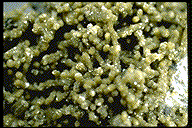 THE
MINERAL CARBOCERNAITE
THE
MINERAL CARBOCERNAITE
 THE
MINERAL CARBOCERNAITE
THE
MINERAL CARBOCERNAITE- Chemistry: (Ca, Na)(Sr, Ce, Ba)(CO3)2 , Calcium Sodium Strontium Cerium Barium Carbonate.
- Class: Carbonates
- Group: Rare earth carbonates.
- Uses: Only as mineral specimens and as a possible source of cerium.
Specimens
Carbocernaite is a rare mineral with an unusual chemistry. It is named in fact for its unusual chemistry reflecting the carbonate (carbo), cerium (cer) and sodium (Na) in its composition.
Cerium is just one of the several rare earth metals that are important to industry. A closely related mineral is called burbankite. Both minerals are considered to be important in the development of rare earth metal containing minerals in carbonatite rocks and are being studied for this reason.
Some rare earth minerals have been found to make pseudomorphs of burbankite and carbocernaite, a testament perhaps of how they play a role in the rare earth minerals' development. Although both contain some rare earth metals, neither is common enough to be considered at present a viable source for these important metals.
Carbocernaite originates to some degree in hydrothermal deposits and nepheline syenites, but more substantially in carbonatite rocks, an unusual igneous rock composed mostly of carbonate minerals.
PHYSICAL CHARACTERISTICS:
- Color is pale yellow, white, rose, brown and colorless.
- Luster is vitreous to greasy.
- Transparency: crystals are transparent to translucent.
- Crystal System is orthorhombic.
- Crystal Habits include small subhedral grains.
- Cleavage is poor in several directions, but not usually seen.
- Hardness is 3.
- Specific Gravity is 3.5 - 3.6 (above average)
- Streak is white.
- Associated Minerals are albite,
burbankite,
bastnasite,
ancylite-(Ce) , cordylite, calcite, ankerite, sphene, monazite, rhabdophane,cerite ,donnayite , synchysite-(Ce),pyrophanite and parisite. - Notable Occurrences are limited to the Weishan deposit, near Jinan City, Shandong Province, China; Mont Saint-Hilaire, Quebec, Canada and the type locality - Vourijarvi, Kola Peninsula, Russia.
- Best Field Indicators: crystal habit, color, luster and locality.








